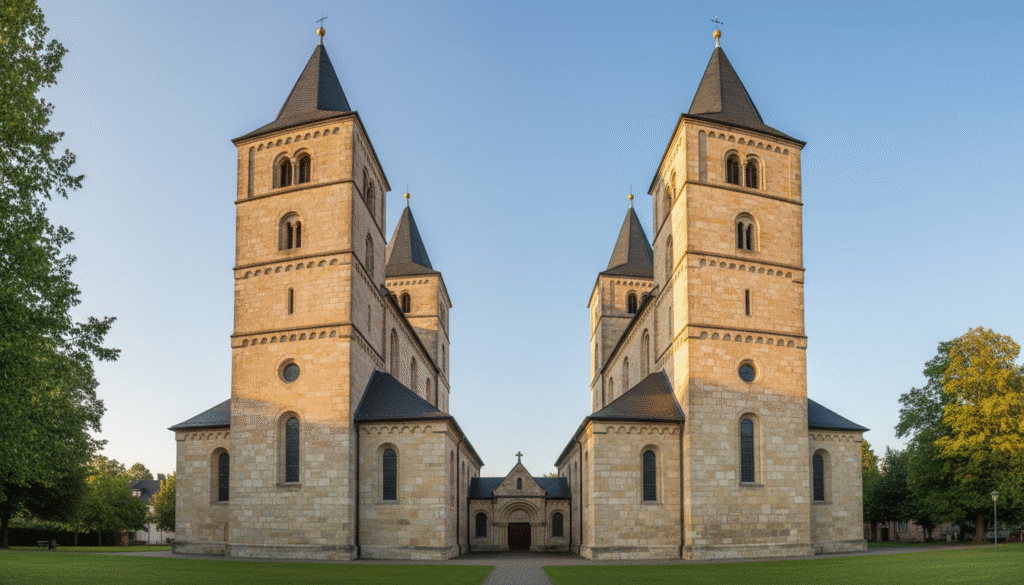When I first heard the term Ottonian architecture, I’ll be honest I had no clue what it meant. It sounded like one of those overly academic things that only historians care about. But then, on a trip to Germany, I walked into a small, quiet church in Hildesheim, and everything changed. The guide said it was one of the best-preserved examples of Ottonian design. The way the sunlight fell through its narrow windows, the heavy stone walls, the calm symmetry it all felt ancient but purposeful, almost spiritual in its stillness.
That moment made me curious. What exactly makes something “Ottonian”? Why is it such a big deal in architectural history? And if someone asked “Which of the following is an example of Ottonian architecture?” how would you even know the answer?
Let’s break it down together, in plain English, the way I wish someone had explained it to me back then.
What Exactly Is Ottonian Architecture?
Ottonian architecture comes from the time of the Ottonian dynasty a line of German rulers who reigned during the 10th and early 11th centuries. This was a period when Europe was slowly rebuilding itself after centuries of instability. People were rediscovering art, religion, and craftsmanship.
Architecture, as it often does, reflected that change. Buildings became symbols of order, power, and divine authority. The Ottonian emperors, inspired by both Roman and Carolingian styles, wanted their churches and monasteries to show strength not through decoration, but through form and balance.
If you ever stand before an Ottonian structure, you’ll notice it doesn’t shout for attention. It’s quiet, sturdy, and deeply symmetrical. The walls are thick, the towers are square and solid, and the windows are small, letting in just enough light to make the interior feel sacred rather than showy.
The Signature Features of Ottonian Design
Let’s look at what sets this style apart. Here are a few hallmarks that define the Ottonian aesthetic:
1. Massive Westwork (Western Façade)
The westwork is like the face of the building a grand, monumental entryway usually flanked by towers. It was designed to impress, but not overwhelm. Standing before it, you’d feel the weight of faith and empire in stone form.
2. Double-Ended Churches
Unlike most modern churches with one rounded end (apse), many Ottonian churches have two one on each side. This created symmetry and made ceremonial processions more fluid.
3. Alternating Columns and Piers
Inside, you’ll often notice an alternating rhythm column, pier, column, pier. It’s subtle, but it gives the building a sense of harmony that’s both visual and structural.
4. Thick Walls and Small Windows
Since large glass openings weren’t structurally possible yet, Ottonian builders relied on small, rounded windows. The result? A dim, peaceful atmosphere that made worship feel intimate and contemplative.
5. Mathematical Proportions
Everything about Ottonian architecture was planned carefully from the placement of doors to the spacing between pillars. Builders used geometry to represent divine order.
Real Examples of Ottonian Architecture

Alright, let’s get to the fun part the buildings themselves. If someone asks “which of the following is an example of Ottonian architecture?” these are the names that should come to mind.
St. Michael’s Church, Hildesheim
If there’s one building that defines this entire style, it’s St. Michael’s Church. Built around 1000 AD by Bishop Bernward, it’s basically the Ottonian blueprint. The church has everything a perfect balance, double apses, alternating columns, and that signature westwork.
The moment you walk inside, it’s impossible not to feel something. The layout is so precise that you can almost sense the builder’s obsession with symmetry. Every angle feels deliberate. Every beam, perfectly aligned.
Abbey Church of Essen
Located in modern-day North Rhine-Westphalia, this church has its own quiet power. It was built under Abbess Mathilde, who belonged to the royal Ottonian family. The church combines Roman inspiration with German engineering, featuring sturdy towers and an octagonal westwork that later inspired many Romanesque buildings.
St. Cyriakus, Gernrode
This one doesn’t get as much attention, but it’s a gem. Built in the 10th century, St. Cyriakus still has most of its original Ottonian structure. When you step inside, you’ll see plain stone walls and wooden ceilings that speak of honesty and craftsmanship. No exaggeration, no drama just solid beauty.
Why the Ottonian Style Still Matters
Now, you might think why should we care about a thousand-year-old church style? Fair question. But here’s the thing: Ottonian architecture quietly influenced almost every major European style that followed.
The order, the symmetry, the geometry these became the building blocks of Romanesque and even early Gothic architecture. The Ottonians didn’t just design buildings; they defined a visual language that carried Europe from chaos into structure.
Even modern architects study Ottonian buildings for their balance and restraint. In a world obsessed with glass towers and flashy designs, there’s something refreshing about a structure that doesn’t need to prove itself. It simply stands there timeless, confident, unbothered.
How to Recognize Ottonian Architecture When You See It
Here’s a quick mental checklist I use whenever I’m exploring old European churches:
- Twin towers at the front? Check.
- Rounded arches instead of pointed ones? Check.
- Small windows and thick stone walls? Check.
- Perfect symmetry from front to back? Definitely check.
- Two apses instead of one? You’ve likely found an Ottonian.
If all of these line up, congratulations you’re probably looking at something over a thousand years old, designed when kings ruled both with swords and sacred symbols.
A Little Human Touch in Stone
One thing I love about Ottonian architecture is that it feels human. You can see where the builders measured by hand, where they aligned stones using ropes and simple geometry. There’s a warmth in that imperfection.
These buildings remind me that architecture isn’t just about beauty it’s about intention. The Ottonians built their churches not to impress other people, but to honor something higher. And that intention gives these places a soul.
Funny enough, the same philosophy shows up in modern design trends like Architecture with Textile Innovation where structure, balance, and light work together in harmony. It’s proof that good design never really dies; it just changes form.
Practical Takeaways (Even If You’re Not an Architect)
If you’re not into history or design, Ottonian architecture still has a few lessons worth keeping in mind:
- Balance over excess. You don’t need to overdecorate something for it to be beautiful. Simplicity has its own kind of power.
- Purpose defines design. Every feature in those buildings had meaning every angle, every column.
- Durability matters. The fact that these churches still stand today says everything about craftsmanship.
- Design reflects values. Whether you’re building a structure, a brand, or a life the principles are the same.
FAQs About Ottonian Architecture
1. Which of the following is an example of Ottonian architecture?
St. Michael’s Church in Hildesheim, Germany, is the most famous and textbook example of this style.
2. When did Ottonian architecture develop?
It emerged in the 10th century, during the reign of the Ottonian emperors, and lasted until around 1024 AD.
3. What came after Ottonian architecture?
The Romanesque style followed, expanding on Ottonian principles with heavier vaulting and more elaborate facades.
4. What are the main features that define it?
Thick walls, small windows, twin towers, double apses, alternating columns and piers, and a strong focus on symmetry.
5. Why is it historically significant?
Because it marked a turning point in European architecture bridging early medieval simplicity and the grandeur that came after.
Final Thoughts
Ottonian architecture isn’t just about old churches it’s about vision. It’s about the courage to build something stable in uncertain times, to bring harmony out of chaos.
When I stood in that quiet church years ago, I didn’t just see stone and arches. I saw the fingerprints of people who believed in balance, who built for eternity rather than applause.
So next time someone asks you, “Which of the following is an example of Ottonian architecture?” you’ll know the answer but more than that, you’ll understand the story behind it. And trust me, that story is worth remembering.


